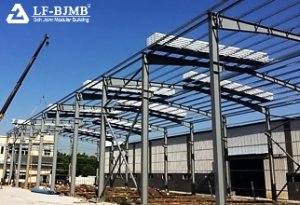+86 177 5193 6871
222, Block B, Diamond International, Guozhuang Road, Xuzhou, Jiangsu, China
While steel structures are widely used, their usage and their own problems have led to frequent accidents. The related accident risks present the following characteristics:
1) Structural form with the most accidents in industrial plants (including common light steel roof frame).
2) Accidents occur most frequently in the utilization stage.
3) Accident types are most frequent in the overall collapse of steel structure.
4) The damage form of the accidents is the most destabilizing damage of steel structure, in addition, brittle fracture accidents and welding connection damage accidents also account for a larger proportion.
5) The causes of the accidents are most frequently due to the quality of fabrication and installation.

Collapse and overturning attribution analysis and risk prevention and control measures
1、Cause analysis of collapse/tipping accident damage
Stability is the most prominent problem of steel structure. The destabilization accidents of steel structure are divided into two categories: overall destabilization accidents and local destabilization accidents, and their respective causes are as follows.
(1) Cause analysis of overall destabilization accidents
① Design error. Design error is mainly related to the level of designers. Such as the lack of stability concept, the stability of the calculation formula is wrong, only calculate the basic components of stability, ignoring the stability of the overall structure of the calculation, the calculation of the sketch and the support constraints and the actual force does not match the design of the safety reserve is too small and so on.
② production defects. Production defects usually include the initial bending of components, initial eccentricity, hot rolling and cold working and residual deformation caused by bursting.
③ The temporary support in the process of steel structure installation is set up unreasonably or the quantity is insufficient, which will make part of the members lose stability, and cause the whole structure to collapse or overturn in the process of construction.
④ Improper use. After the structure is completed and put into use, improper use or accidental factors are also the main causes of destabilizing accidents. For example, the use of the user arbitrarily transform the use of function; change the stress state of the components; overload caused by the accumulation of dust or increase the suspension equipment; uneven settlement of the foundation and additional deformation caused by temperature stress; accidental impact load, etc..
(2) Local instability accident cause analysis
Local instability is mainly for components, the consequences of its instability, although not as serious as the overall instability, but should also attract enough attention.
①Design error. Designers ignore or even do not carry out local stability calculation of members, or acceptance method is wrong, resulting in the composition of members of various types of plates width-thickness ratio and height-thickness ratio is greater than the normative limit.
② improper construction. Usually in the member of the local concentrated force should be set up in the part of the structure of the stiffening ribs, and to ensure that the member is not deformed in the process of operation must be set up across the partition, stiffening ribs and so on. However, in the actual project, the number of stiffening ribs is not enough to construct the phenomenon of improper construction is more common.
③Original defects. Including the negative tolerance of steel serious over specification, welding and other processes in the production process to produce localized bulging and wavy deformation.
④Unreasonable location of lifting point. It is very important to select the location of lifting point for large steel structure members, sometimes the excessive compressive stress inside the member will lead to local instability of the member in the lifting process.
2、Collapse/Tipping Risk Prevention and Control Measures
The following principles should be observed for the prevention and control of steel structure instability risk:
(1) Designers should strengthen the concept of stability design.
To prevent the occurrence of steel structure instability accident, designers have the most important responsibility. It is necessary to strengthen the concept of stability design.
①The overall arrangement of the structure must consider the stability requirements of the whole system and its components, especially the arrangement of the support system. ② The prerequisite assumptions of the structural stability calculation method must be in line with the actual stress situation, especially the influence of the support constraint. ③ The stability calculation of components and the stability calculation of detailed structure must be coordinated, especially the concept of strong nodes.④The stability problem should be handled with an overall viewpoint, and the relevant effects of overall stability and local stability should be considered.
(2) The production unit should strive to minimize defects
Among the many common defects, initial bending, initial eccentricity, and residual stresses have the greatest influence on the stable bearing capacity. Therefore, the fabrication unit should minimize the defects through reasonable processes and quality control measures.
(3) Construction unit should ensure the safety of the installation process
Only by making scientific construction organization design, adopting reasonable lifting scheme and carefully arranging temporary support, the construction unit can prevent the steel structure from destabilization during installation and ensure the safety of the structure.
(4) The user unit should use the steel structure building normally
On the one hand, the user unit should pay attention to the regular inspection and maintenance of the constructed steel structure; on the other hand, when it is necessary to carry out the transformation of the process and the use function, it must consult with the design unit or the relevant professionals, and shall not increase the load or change the force of the components without authorization.
